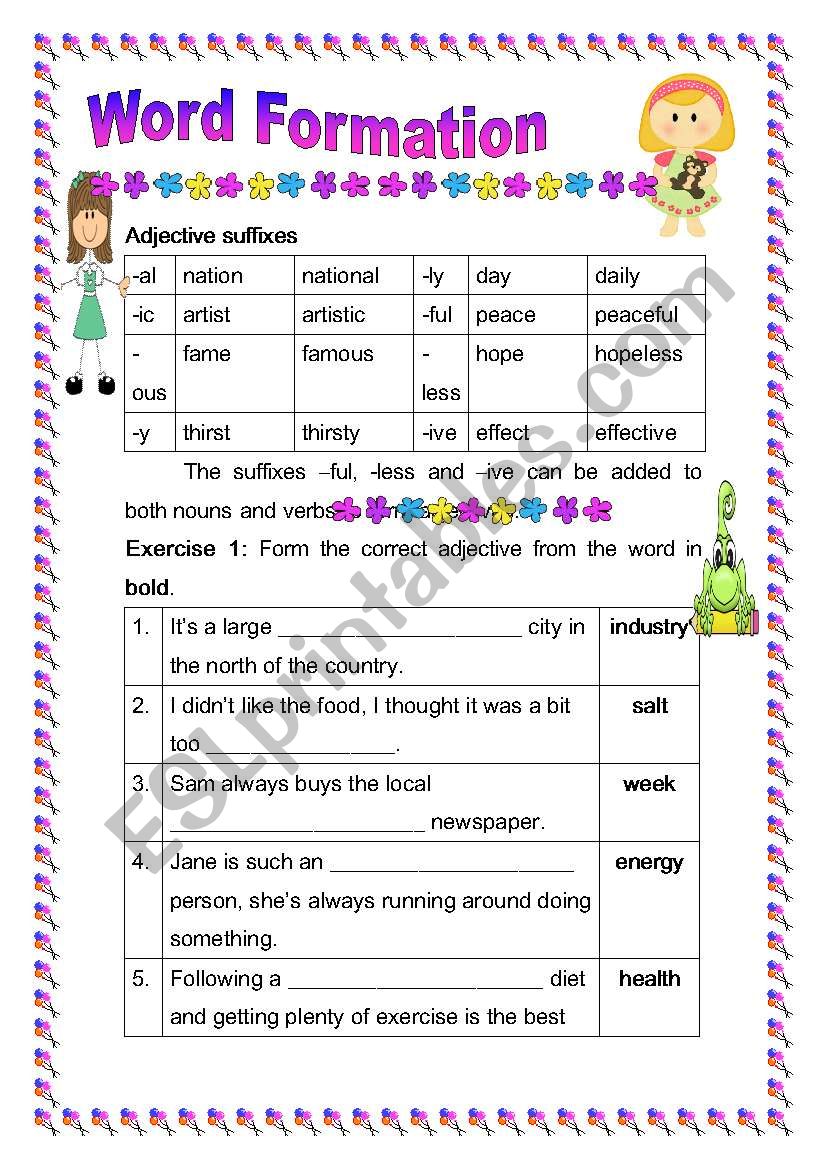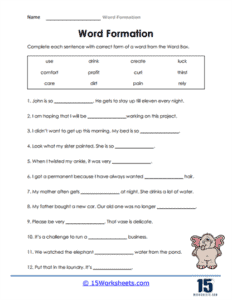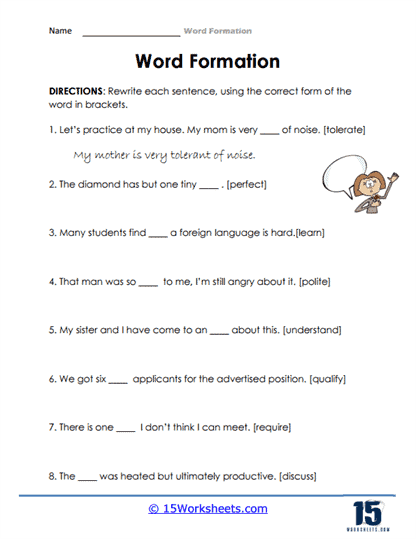
Unlocking Vocabulary Mastery: A Comprehensive Guide to Word Formation Worksheets
Language is a living, breathing entity, constantly evolving and expanding. A significant part of this dynamism lies in the ability to create new words or modify existing ones to suit various communicative needs. This process, known as word formation, is a cornerstone of linguistic competence, offering learners a powerful tool to understand, expand, and utilize vocabulary effectively. For educators and language learners alike, mastering word formation can transform vocabulary acquisition from rote memorization into an intuitive and systematic process. This is where Word formation worksheets emerge as invaluable educational resources.
What is Word Formation and Why Does it Matter?
Word formation refers to the processes by which new words are created or existing words are changed in form and meaning. It encompasses a range of linguistic mechanisms that allow us to build a vast lexicon from a relatively smaller set of base words. Understanding these processes is not merely an academic exercise; it has profound practical implications for language learners:

- Vocabulary Expansion: Instead of learning thousands of individual words, learners can grasp patterns (e.g., adding a prefix like ‘un-‘ to create an opposite) and unlock an entire family of related words.
- Reading Comprehension: Recognizing familiar roots, prefixes, and suffixes helps decipher the meaning of unfamiliar words encountered in texts.
- Speaking and Writing Fluency: A deeper understanding of how words are constructed allows learners to use a wider range of vocabulary appropriately and accurately, enhancing their expressive capabilities.
- Grammar Reinforcement: Many word formation processes involve changing a word’s part of speech (e.g., noun to verb, adjective to adverb), thereby reinforcing grammatical concepts.




Given its critical role, systematic instruction in word formation is essential. And for this, Word formation worksheets provide the structured practice necessary for learners to internalize these complex linguistic patterns.
The Power of Word Formation Worksheets
Word formation worksheets are not just simple exercises; they are carefully designed tools that facilitate active learning and reinforce understanding. Their effectiveness stems from several key advantages:

- Structured Practice: They break down complex linguistic concepts into manageable chunks, allowing learners to focus on one specific aspect of word formation at a time.
- Active Engagement: Rather than passively receiving information, learners actively manipulate words, fostering deeper processing and retention.
- Pattern Recognition: Through repeated exposure and practice, worksheets help learners identify and internalize common prefixes, suffixes, and other word-building rules.
- Contextual Learning: Many effective worksheets embed word formation tasks within sentences, paragraphs, or real-world scenarios, helping learners understand how words are used naturally.
- Self-Correction and Feedback: Well-designed worksheets often come with answer keys, enabling learners to check their work, identify mistakes, and learn from them independently.
- Differentiation: Worksheets can be tailored to various proficiency levels, from basic recognition tasks for beginners to more complex creative exercises for advanced learners.
- Measurable Progress: They provide concrete evidence of learning, allowing both learners and educators to track improvement over time.



Key Types of Word Formation and Corresponding Worksheet Ideas
To create truly effective Word formation worksheets, it’s crucial to understand the main processes involved. Here’s a breakdown of common word formation types and practical ideas for worksheet activities:
1. Derivation (Affixation: Prefixes and Suffixes)
This is arguably the most common type of word formation, involving the addition of prefixes (at the beginning of a word) or suffixes (at the end of a word) to change its meaning, grammatical function, or both.
-
Prefixes:
- Concept: Prefixes like
un-(opposite),re-(again),pre-(before),mis-(wrongly),dis-(not/opposite) alter the meaning of the base word. - Worksheet Ideas:
- Matching: Match prefixes to root words (e.g.,
un-tohappy,re-towrite). - Word Building: Provide a list of prefixes and a list of root words; learners combine them to create new words.
- Sentence Completion: Fill in the blanks with the correct word formed by adding a prefix (e.g., "I need to _____ my homework because I made many mistakes." do/redo).
- Antonym Creation: Give a list of words and ask learners to create their antonyms using appropriate prefixes (e.g.,
agree->disagree,possible->impossible).
- Matching: Match prefixes to root words (e.g.,
- Concept: Prefixes like
-
Suffixes:
- Concept: Suffixes often change the part of speech of a word (e.g., verb to noun, adjective to adverb) or indicate a specific quality. Examples include
-tion(noun),-able(adjective),-ly(adverb),-ness(noun),-ment(noun). - Worksheet Ideas:
- Part of Speech Transformation: Give a word and ask learners to change its part of speech using a suffix (e.g.,
educate(V) ->education(N),quick(Adj) ->quickly(Adv)). - Suffix Identification: Provide sentences with words containing suffixes and ask learners to identify the suffix and the base word.
- Categorization: Group words by the suffix they contain and discuss the meaning or grammatical function associated with each suffix.
- Creative Writing: Ask learners to write sentences or a short paragraph using a given set of words, transforming them with specific suffixes to fit the context.
- Part of Speech Transformation: Give a word and ask learners to change its part of speech using a suffix (e.g.,
- Concept: Suffixes often change the part of speech of a word (e.g., verb to noun, adjective to adverb) or indicate a specific quality. Examples include
2. Compounding
This involves combining two or more existing words to form a new word, which often has a meaning different from the sum of its parts. Compounds can be written as one word (closed), hyphenated, or as separate words (open).
- Concept:
sun + flower = sunflower,black + board = blackboard,software,living room. - Worksheet Ideas:
- Word Pairing: Provide two columns of words and ask learners to match them to form compound words.
- Compound Word Classification: Give a list of compound words and ask learners to classify them as closed, hyphenated, or open.
- Picture Matching: Use images to represent compound words and ask learners to write the compound word.
- Sentence Building: Use given compound words in meaningful sentences.
3. Conversion (Zero Derivation)
This process involves changing the grammatical category of a word without adding any affixes. The word’s form remains the same, but its function changes.
- Concept:
access(N) ->access(V),empty(Adj) ->empty(V),book(N) ->book(V). - Worksheet Ideas:
- Sentence Analysis: Provide sentences where the same word is used as different parts of speech and ask learners to identify its function in each sentence.
- Sentence Creation: Give a list of words that can undergo conversion and ask learners to write two sentences for each word, demonstrating its use as different parts of speech.
- Role-Playing: Short dialogues where words are used in different converted forms.
4. Blending
Blending involves combining parts of two or more words to create a new word, typically by taking the beginning of one word and the end of another.
- Concept:
smoke + fog = smog,breakfast + lunch = brunch,information + commercial = infomercial. - Worksheet Ideas:
- Origin Identification: Provide blended words and ask learners to identify the original words they came from.
- Blend Creation: Give two words and ask learners to create a plausible blend (e.g.,
motor+hotel=motel). - Contextual Use: Use blended words in sentences or short texts, asking learners to infer their meaning.
5. Clipping
Clipping involves shortening a word by omitting one or more syllables without changing its meaning or part of speech.
- Concept:
advertisement->ad,influenza->flu,photograph->photo,telephone->phone. - Worksheet Ideas:
- Full Word/Clipped Word Matching: Match the full form of a word to its clipped version.
- Informal vs. Formal: Discuss when it’s appropriate to use clipped forms (usually informal contexts).
- Sentence Transformation: Rewrite sentences using the clipped forms of words where appropriate.
6. Acronyms and Initialisms
Acronyms are formed from the initial letters of a series of words and are pronounced as a word (e.g., NASA, NATO). Initialisms are also formed from initial letters but are pronounced letter by letter (e.g., USA, UK, FBI).
- Concept:
National Aeronautics and Space Administration->NASA. - Worksheet Ideas:
- Expansion: Provide acronyms/initialisms and ask learners to write out what they stand for.
- Creation: Ask learners to create their own acronyms/initialisms for given phrases or concepts.
- Contextual Usage: Use common acronyms/initialisms in sentences.
7. Back-formation
This process involves creating a new word (usually a verb) by removing what is mistakenly perceived as an affix from an existing word.
- Concept:
editor(N) ->edit(V),television(N) ->televise(V),babysitter(N) ->babysit(V). - Worksheet Ideas:
- Origin Tracing: Provide a back-formed word and ask learners to identify the original word it came from.
- Sentence Building: Use both the original and the back-formed word in different sentences.
Designing Effective Word Formation Worksheets
To maximize the impact of Word formation worksheets, consider these design principles:
- Clear Instructions: Ensure learners know exactly what to do. Use simple, direct language.
- Varied Activities: Mix and match activity types (matching, fill-in-the-blanks, sentence writing, categorization) to keep learners engaged.
- Gradual Progression: Start with simpler concepts and move to more complex ones. Begin with recognition and move to production.
- Contextualization: Integrate words into meaningful sentences, short paragraphs, or dialogues. Avoid isolated word lists.
- Visual Appeal: Use clear fonts, appropriate spacing, and occasional relevant images to make the worksheet inviting.
- Answer Keys: Provide self-correction opportunities, which is crucial for independent learning.
- Differentiation: Offer different versions or extension activities for learners at varying proficiency levels.
- Relevance: Choose words that are common, useful, and relevant to the learners’ experiences or curriculum.
Integrating Word Formation Worksheets into the Curriculum
Word formation worksheets can be seamlessly integrated into various aspects of language learning:
- Pre-teaching: Introduce new vocabulary families before reading a text.
- Reinforcement: Practice concepts introduced in class.
- Homework: Provide independent study and consolidation.
- In-class Activities: Facilitate pair work or group discussions.
- Assessment: Evaluate understanding of word formation rules.
- Revision: Review previously learned vocabulary.
Challenges and Solutions
While Word formation worksheets are highly beneficial, some challenges may arise:
- Overwhelm: The sheer number of prefixes, suffixes, and rules can be daunting.
- Solution: Focus on the most common and productive affixes first. Break down the topic into smaller, manageable units.
- Rote Learning: Learners might memorize rules without truly understanding the underlying patterns.
- Solution: Emphasize pattern recognition, provide ample examples, and encourage learners to explain the meaning changes.
- Lack of Context: Worksheets that only list words can be dry and ineffective.
- Solution: Always embed tasks in meaningful sentences, short stories, or real-world scenarios.
- Boredom: Repetitive tasks can lead to disengagement.
- Solution: Incorporate games, competitive elements, or creative writing tasks to make learning fun.
Conclusion
Mastering word formation is a gateway to true vocabulary mastery in English. It equips learners with the analytical tools to decode new words, expand their lexicon systematically, and express themselves with greater precision and fluency. Word formation worksheets, when thoughtfully designed and effectively implemented, serve as indispensable resources in this journey. They provide the structured practice, active engagement, and contextual learning necessary to transform complex linguistic concepts into intuitive knowledge. By embracing the power of Word formation worksheets, educators can empower their students to become independent and confident users of the English language, ready to navigate its rich and ever-expanding vocabulary.
